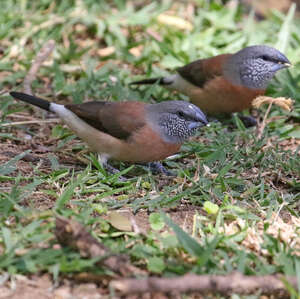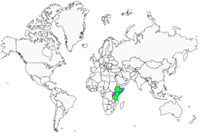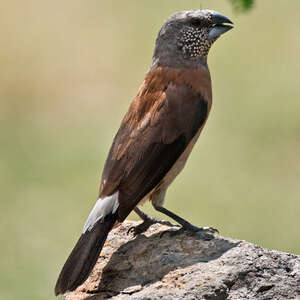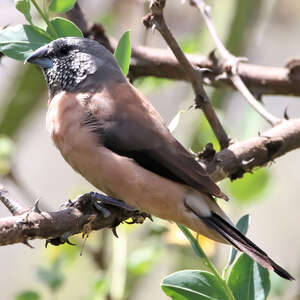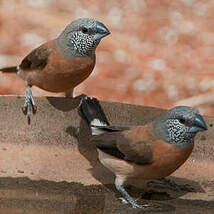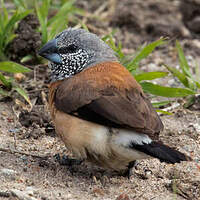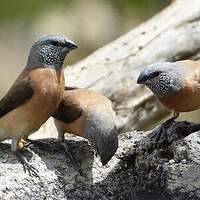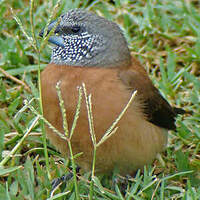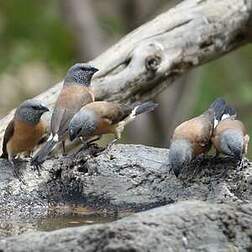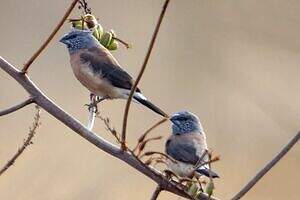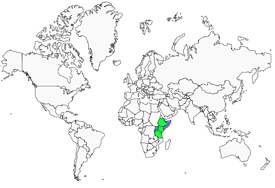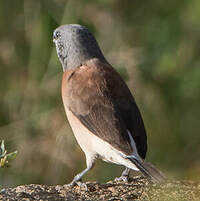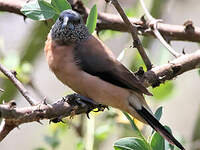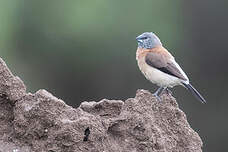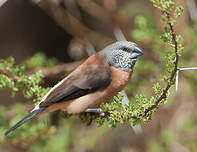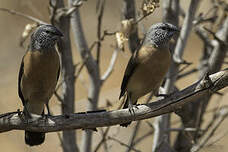Grey-headed Silverbill
Spermestes griseicapilla - Capucin à tête grise
Identification
The Grey-headed Silverbill is a small East-African Estrildid. Adult males and females are alike in appearance. The head is ash-coloured, with the face widely speckled with small, pearlescent white dots on a dark grey background. The short, high beak is laterally depressed with rolled margins. It is steel-grey in colour, with a bluish tint in the lower mandible. The iris is dark brown. The mantle and the back are light chestnut brown, the rump and the tail-coverts are white. The wings and the tail are slaty black, the primaries with covers and the tertiaries brown. The underparts are a well-marked rosy fawn on the chest, which can recall the colour of the mantle, and gradually become paler until finally becoming russet-brown at the undertail-coverts. The legs are grey.
The juvenile resembles the adult, but without the white spots on the head. These spots only appear during the first moult, at eight weeks. The wing-covers and the tertiaries have light beige edging.
Subspecific information monotypic species
Foreign names
- Capucin à tête grise,
- Capuchino cabecigrís,
- freirinha-de-cabeça-cinzenta,
- Graukopfelsterchen,
- szürkefejű amandina,
- Grijskopzilverbekje,
- Becco d'argento testagrigia,
- pärlhalsmunia,
- Gråhodesølvnebb,
- mníška perlolíca,
- amadina perlolící,
- Perlehalsamadine,
- huppuhopeanokka,
- maniquí capgrís,
- mniszka łuskolica,
- Жемчужноголовая амадина,
- オキナチョウ,
- 斑颊文鸟,
- 灰頭銀嘴文鳥,
Voice song and cries
Habitat
The Grey-headed Silverbill inhabits acacia and other thorn scrub, open forests and bushy grassland, ranging from sea level up to 2,400 metres in altitude. It is occasionally found on the edges of cultivated areas and gardens, provided that there are tall grasses which it would feed on the seeds of. It enjoys being near sources of water and rivers, where it will come to drink regularly.
Behaviour character trait
The Grey-headed Silverbill is gregarious and sociable. It readily accepts the presence of other species, like the Silverbill, in areas where their ranges overlap. It lives, feeds, and moves in groups of up to 30 individuals, including at night when they make sleeping groups in old nests. They occasionally build nests for this purpose. The species is sedentary but, outside the breeding season, the birds are not hesitant to wander.
Dietfeeding habits
Reproduction nesting
At the end of the rainy season, the breeding season begins. This starts with displays. The male, carrying a blade of grass in its beak, hops towards the female.
He then drops the blade of grass and sings his most beautiful melody. With a wagging tail the female shows her receptiveness.Confronted with other males, the legitimate male raises the white spotted feathers on its head in an attempt to impress its competitors.
The nest, oval in shape with a lateral entrance, is made up of dry grass gathered and held together by vegetable fibres. It is lined with feathers and down on the inside. It is built in a tree, a spiny bush or under a thatched roof. During the day, male and female take turns to incubate the 4 or 5 eggs laid according to a rule each bird respects. When the bird reaches the nest, the first bird calls out and only enters when the second responds and leaves. The male that comes to relieve the female also brings some extra material to reinforce the nest. The adults spend the night together in the nest.
Incubation lasts 14 days. The young are mainly fed insects and larvae and leave the nest at the age of 3 weeks. They are independent two weeks later. Observers have reported that males bring dried earth to the nest once the eggs have hatched. The fact and use of this supply are yet to be demonstrated.
Several broods can successively appear during the season.
Geographic range
Threats - protection
Sources of information
- IOC World Bird List (v14.1), Gill, F and D Donsker (Eds). 2023.
- Finches and Sparrows, Peter Clement
- HBW Alive,
- Avibase, Lepage Denis
- xeno-canto, Sharing bird sounds from around the world,
- Finch Information Center,
Other sources of interest
 Specification sheet created on
20/07/2023 by Nathalie Santa Maria
Specification sheet created on
20/07/2023 by Nathalie Santa MariaTranslation by AI Oiseaux.net
published: 24-10-2019 - Updated: 29-10-2019
© 1996-2024 Oiseaux.net
- Accipitriformes
- Aegotheliformes
- Anseriformes
- Apodiformes
- Apterygiformes
- Bucerotiformes
- Caprimulgiformes
- Cariamiformes
- Casuariiformes
- Charadriiformes
- Ciconiiformes
- Coliiformes
- Columbiformes
- Coraciiformes
- Cuculiformes
- Eurypygiformes
- Falconiformes
- Galliformes
- Gaviiformes
- Gruiformes
- Leptosomiformes
- Mesitornithiformes
- Musophagiformes
- Nyctibiiformes
- Opisthocomiformes
- Otidiformes
- Passeriformes
- Pelecaniformes
- Phaethontiformes
- Phoenicopteriformes
- Piciformes
- Podargiformes
- Podicipediformes
- Procellariiformes
- Psittaciformes
- Pterocliformes
- Rheiformes
- Sphenisciformes
- Steatornithiformes
- Strigiformes
- Struthioniformes
- Suliformes
- Tinamiformes
- Trogoniformes

